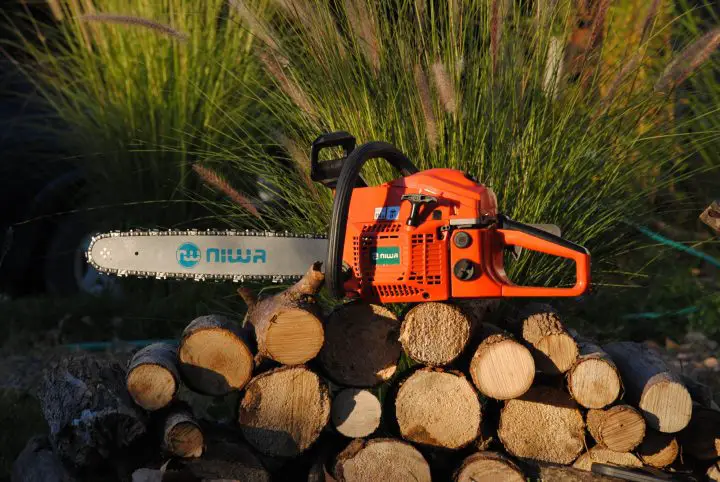The majority of chainsaws that run on gas have 2- or 4-cycle engines. Each has advantages and downsides, as well as justifications for using them and justifications for not using them. You should think about the type of engine it has when choosing a chainsaw.
In this article, we’ll discuss all you need to know about 4-cycle chainsaws vs 2-cycle chainsaws, including which is better so you know which one is right for you!
Table of Contents
- 2 Cycle Chainsaw Vs 4 Cycle Chainsaw
- Which Is Better?
- Final Thoughts
- FAQs (Frequently Asked Questions)

2 Cycle Chainsaw Vs 4 Cycle Chainsaw
Motors that use a pre-mixed oil and gas mix are typically categorized as 2-cycle (also known as 2 strokes) engines. Depending on the motor, this mixture, which may range from 50:1 to 20:1, supplies gasoline and lubrication to the motor while it is running.
Four-cycle chainsaws also referred to as four-stroke engines, are more comparable to the ones you typically see in automobiles. A crankcase and a mix oil supply system are also features of 4-stroke engines, which preserve the oil and keep it separate from the fuel mix ratio while lubricating the engine components at the same time. It must also be replaced frequently, typically after 25 hours of use, because the oil was separated.
Up to 10% ethanol may be used in four cycles, which run on the same gas that you buy for your car. As a result, they are simpler to refill than two cycles because you may fill them at your neighborhood gas station.
While on the topic, visit our Can I Use Any 2 Stroke Oil in My Chainsaw? guide if you wish to learn more about the fuel-oil ratio!
Working Principle
The way that 2-cycle and 4-cycle chainsaw engines operate is very different. A four-cycle engine, as one might expect, runs in four phases. The power stroke comes first, followed by the intake, the exhaust, and finally the compression stroke. These four strokes are applied throughout the course of two full rotations.
A 2-cycle engine has simply two cycles, which combine the aforementioned operations. The first stroke combines the input and compressor strokes, whereas the second stroke combines the power and exhaust strokes. Power and combustion take place at the piston’s peak in its stroke. At the bottom are the intake and exhaust. To produce two strokes and propel the piston through the entire cycle, it only takes one revolution.
Advantages and Disadvantages
There are many advantages to using a 4-cycle chainsaw engine, yet 2-cycle motors are more common. They are easier to start and operate, more dependable, and less likely to break. The majority of experts advise using the tested 2-cycle versions since pros do. For high torque concerns, a 4-cycle chainsaw might be the best option. It will do the task but will take more time and effort.
Another thing to keep in mind is that 4-stroke engines cannot run if they are turned upside down or on their side. This is because their oil system depends on gravity, and if they didn’t obtain enough oil, it would swiftly malfunction.
However, since the oil is included in the gasoline in 2-stroke engines, they do not have these issues. They will still work no matter which way you turn them. It is simple to understand why this is significant for chainsaws. When felling a tree, you must constantly hold it sideways; if it had a 4-stroke engine, this would not be possible. Although 4-stroke engines have a significantly higher torque at lower speeds, a 2-stroke engine will accelerate from idle to top speed in a lot less time than a 4-stroke.
The unfortunate reality is that many local rules and regulations today appear to be impacted by the current global climate predicament. 2-cycle chainsaws may be eventually phased out due to stricter pollution standards. When that happens, maybe manufacturers can enhance 4-cycle technology and create products that operate as easily and conveniently as their 2-cycle counterparts.
Which Is Better?
It’s not as simple as you may think to compare a 2-cycle and 4-cycle chainsaw. While some differences are obvious, others are more subtle and more difficult to detect. To begin with, pre-mixed fuel is commonly used to power 2-cycle engines. This has the advantage of lubricating and fuelling the engine at the same time. This is fantastic since it eliminates the need for a separate oil reservoir for anyone operating a two-cycle chainsaw.
As we previously explained, a 4-cycle chainsaw operates similarly to a car or truck. To make sure your power tools keep functioning properly after roughly 25 hours, you should change the oil. When necessary, you can fill it up with unleaded fuel at the nearby gas station. Make sure not to use E85 gas when using a 2 or 4-cycle chainsaw. With either of those kinds of engines, it is ineffective.
There are a lot more moving parts in four-cycle engines. They have a piston, valves, lifters, a connecting rod, a crankshaft, and a camshaft. Actually, there are only three main moving elements in a two-cycle engine. This covers the piston, connecting rod, and crankshaft. Cams, lifters, and valves are absent from compact two-cycle engines. In general, fewer parts mean less chance for failure and simpler maintenance.
Learn all about The Parts of a Chainsaw in our parts list guide!
When compared to a 4-cycle engine, which frequently requires approximately twice the displacement and overall size to produce the same amount of power, 2-cycle engines are typically smaller overall. The 2-cycle produces power twice as quickly as a 4-stroke because it combines two functions into a single rotation.
Final Thoughts
A chainsaw with two cycles has fewer moving components and sealed fuel storage. Additionally, it produces more emissions and burns oil. At the same time, it weighs less and starts more easily. The 4-cycle chainsaw requires more frequent oil changes, weighs more, and uses less fuel while producing fewer emissions. Regulations pertaining to climate change and the environment may make the 4-cycle the sole engine type available in the future.
In summary, a 2-cycle engine is more dependable and simpler to operate, both of which are significant advantages. It is most likely the best option for someone with little prior chainsaw experience. But it also has some negative aspects, like how it affects the environment. A 2-cycle chainsaw is superior in many aspects, including usability, so you should like using it. However, your odds of having a two-cycle chainsaw will be slim to none in the next years.
Other tool comparisons:
FAQs (Frequently Asked Questions)
Is a 4-cycle engine stronger than a 2-cycle?
A 4-stroke engine is typically more enduring than a 2-stroke engine because the latter is made to operate at lower RPMs. Nevertheless, 2-stroke engines are more powerful. Because of their significantly simpler design, two-stroke engines are also simpler to repair. Instead of valves, they have ports.
Is it better to have a 2-stroke or 4-stroke?
A 4-stroke engine of the same size will never outperform a 2-stroke engine in terms of power. As a result, chainsaws are also considerably smaller, which is useful when using them in places where a larger chainsaw would be impractical. For instance, when scaling a tree to remove a potentially hazardous branch.
Are STIHL chainsaws 2-stroke or 4-stroke engines?
2-stroke combustion engines are found in a lot of STIHL chainsaws. But some people employ the 4-MIX engine. Thus, the STIHL 4-MIX engine combines the positive aspects of both 2- and 4-stroke engines. The 4-MIX engine is persuasive in terms of decreased pollutants, easy maintenance, and a pleasing sound, in addition to having plenty of hauling power and noticeably increased torque.




